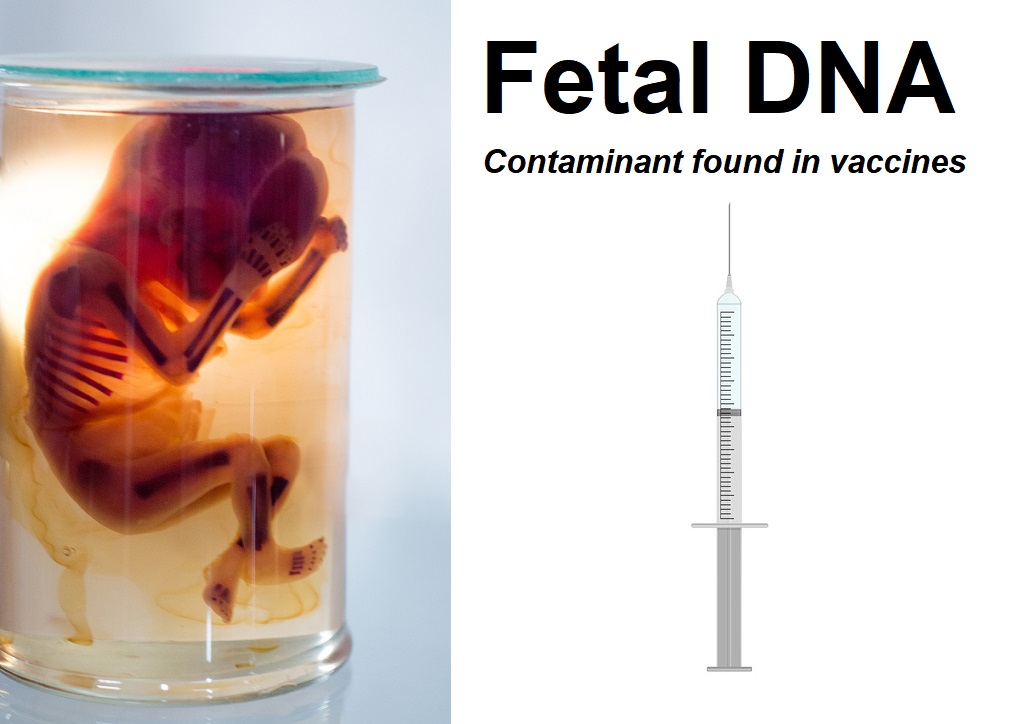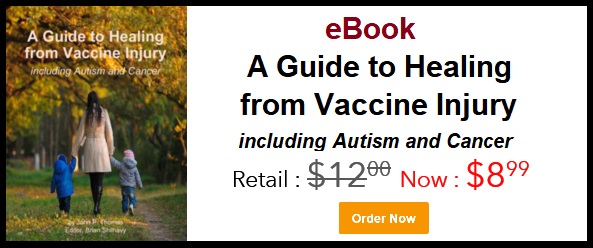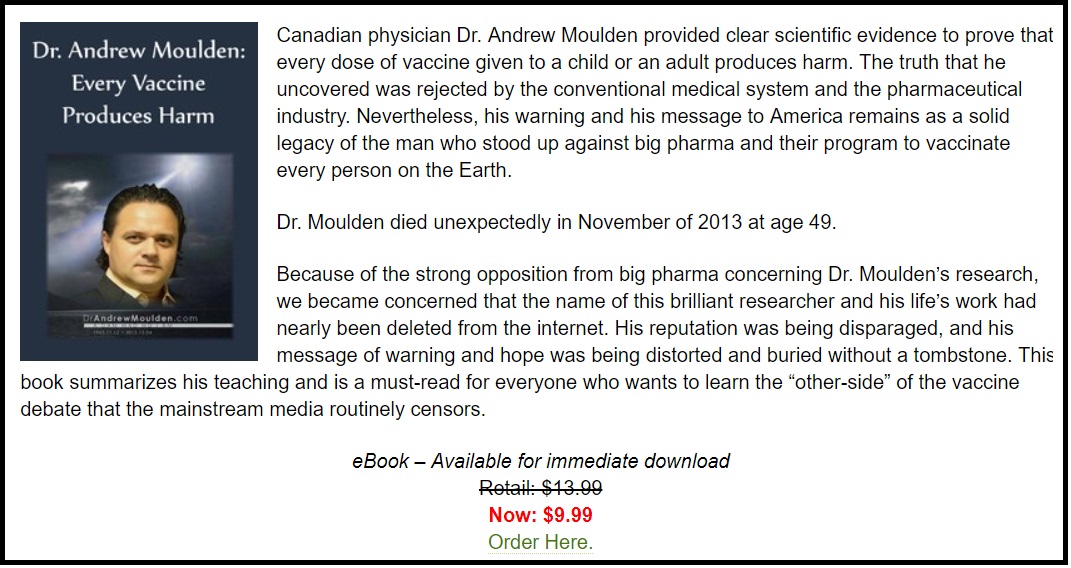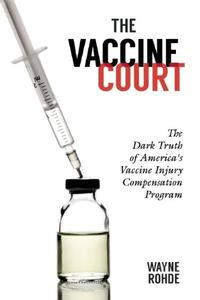
Moral Implications of Aborted Fetuses in Vaccine Production
by Dr. Joseph Mercola
Mercola.com
One commonly cited reason for claiming a religious vaccine exemption has to do with the fact that some vaccines are made using aborted fetal cell lines. As reported in an April 26, 2019, article in Christianity Today:1
“For certain Christians, the decision of whether to vaccinate comes down to the origins of the vaccines themselves. Some pro-life parents cite a moral disgust and a deep lament over the use of 58-year-old aborted fetal cell lines in development for several recommended immunizations, including MMR (measles, mumps, and rubella) and chickenpox …
The fetal cells that disturb parents … originate from material procured from two abortions that took place in the 1960s … For immunizations to work, they require the virus to be hosted in a living cell.
Cell biologist Leonard Hayflick, working at the Wistar Institute in Philadelphia, reasoned that fetal cells would be protected from outside pathogens and the ‘cleanest’ type to use in vaccines.
He partnered with a Swedish scientist to procure the fetal tissue from an elective abortion in a country where it was legal … Vaccine-makers still use the cell lines called WI-38 today.
These fetal cells from the “Mrs. X” abortion were used to grow weakened or inactive viruses in the development of two vaccines: the rubella vaccine (the R in the MMR vaccine) and one version of rabies vaccine …
Around the same time, the British Medical Council in the UK also produced vaccines from fetal lung cells. Using cells procured through an abortion in 1966, a culture called MRC-5, they created vaccines for hepatitis A, chickenpox, and shingles. A polio vaccine was also made and used in other countries but not the U.S.”
An Ethical Dilemma for Many of Faith
Vaccine manufacturing is not dependent on the ongoing procurement of aborted fetal tissue, and the Catholic Church issued a statement2 in 2005 assuring Catholics that by getting vaccinated they are not “cooperating in evil.”
Yet the idea of injecting themselves or their children with a substance manufactured using aborted fetal cells still makes some Christians, Jews, Muslims and those of other faiths or personal beliefs feel morally uneasy.3 Pro-vaccine advocates and most agnostics have a hard time comprehending why though. As reported by Christianity Today:4
“National Institute of Health director Francis Collins suggests comparing it to organ donation after a child was shot. ‘There was a terrible, evil loss of life of that child and yet I think we would all say that if the parents decided and they wanted something good to come of this and gave their consent, that’s a noble and honorable action,’ he said.
‘Does that translate into a parent, after going through a pregnancy termination, deciding that they would like the fetal tissue to actually help somebody?’”
However, the article points out that the consent issue actually presents a second ethical dilemma rather than solving the first.
Since the fetal tissues were obtained in an era before medical informed consent really became the norm, there’s no guarantee either that the two women gave such consent, or understood that their fetuses’ cell lines would be used to create injectable vaccines for decades to come. An article on Patheos.com also discusses this issue, displaying the typical intolerance:5
“Here’s what confuses me. People are allowed to donate organs. Parents can even donate their children’s organs. We typically see this as a good thing …
Those two abortions were not performed to obtain fetal tissues for vaccines. They were elective abortions that would have been performed regardless of scientists’ interest in using fetal cells … for developing vaccines.
I understand that abortion opponents see those two abortions as murder. But you know what? When a child or an adult is murdered, their organs can still be donated … If the child is dead either way, why not donate their organs?
…
I’ve heard some suggest that vaccines contain residual fetal DNA. Even if that is the case, why would that be so different from cases where someone receives a heart transplant, or a kidney transplant? … Or what about a blood transfusion?”
Is Using Animal Cells a Morally Superior Choice?
Clearly, this issue is far from cut and dry, but I think it’s important to at least try to empathize with another person’s point of view. The author of the Patheos article concludes that, most likely, the religious objection to vaccines made with fetal cells has more to do with the “ick factor,” opposed to the sentiment that it’s tissue obtained from murder and therefore immoral to partake in.
However, that is conjecture as many individuals have deeply held religious beliefs opposing abortion and use of aborted fetal tissue for scientific research or other purposes.
Today, many other types of cells are used as growth mediums during vaccine production, and many of those raise moral issues as well. Vaccine growth mediums include6 animal cell strains from chickens, dogs, monkeys, hamsters7 and insects,8 as well as cells from bacteria or yeast.
As just one example, the flu vaccine Flucelvax, introduced in 2014, is grown in kidney cells from dogs.9 Bovine serum (from cow’s blood) is also used for some vaccine components, and trace amounts may remain in the vaccine.10 The use of animal cells doesn’t entirely solve the moral dilemma for all religious faiths though. As noted by Christianity Today:11
“There is a subset of the Christian opposition to vaccines that also takes issue with certain animal cells used in medical research, citing concerns over Levitical guidelines on animals and blood products …”
Other Reasons to Question Human Fetal Cell Line Vaccines
Regardless of whether you believe the use of fetal cells from abortions in vaccine production is morally reprehensible or completely justified, there may be other reasons to object to being coerced or compelled to use vaccines — or give your children vaccines — that were made using human fetal tissue cells.
According to a study published in the September 2014 issue of the Journal of Public Health and Epidemiology,12 rates of autism strongly correlate with the introduction of vaccines using human fetal cell lines.
Three vaccines in particular were found to be significantly correlated with autism: MMR, varicella (chickenpox) and hepatitis A vaccines. According to the study authors, autism rates rose sharply each time one of these vaccines was released. As reported in this paper:13
“The children vaccinated with MMRII, Varicella and Hepatitis A vaccines varied from 19 to 35 months of age at the time of vaccination. Autistic disorder birth year change points were identified as 1980.9, 1988.4 and 1996 for the US, 1987 for UK, 1990.4 for Western Australia, and 1987.5 for Denmark.
Change points in these countries corresponded to introduction of or increased doses of human fetal cell line-manufactured vaccines … Further, linear regression revealed that Varicella and Hepatitis A immunization coverage was significantly correlated to autistic disorder cases. R software was used to calculate change points.
Autistic disorder change points years are coincident with introduction of vaccines manufactured using human fetal cell lines, containing fetal and retroviral contaminants, into childhood vaccine regimens.
This pattern was repeated in the US, UK, Western Australia and Denmark. Thus, rising autistic disorder prevalence is directly related to vaccines manufactured utilizing human fetal cells.”
Part of the problem has to do with what’s called “insertional mutagenesis,” where DNA mutations are created via a viral vector, either naturally or intentionally.14 Indeed, a U.S. Food and Drug Administration Powerpoint presentation15 from 2005 discusses the history of cell-substrate DNA in biological products and some of the “perceived safety issues associated with DNA.” As reported by Global Research in September 2014:16
“… Dr. Theresa Deisher, lead scientist and SCPI founder noted that, ‘Not only are the human fetal contaminated vaccines associated with autistic disorder throughout the world, but also with epidemic childhood leukemia and lymphomas’ …
Instead of conducting safety studies [the U.S. Food and Drug Administration] regulated the amount of human DNA that could be present in a vaccine to no greater than 10ng17 … Deisher’s team discovered that the fetal DNA levels ranged anywhere from 142ng – 2000ng per dose, way beyond the so-called ‘safe’ level.
‘There are a large number of publications about the presence of HERV (human endogenous retrovirus — the only re-activatable endogenous retrovirus) and its association with childhood lymphoma,’ noted Dr. Deisher.
‘The MMR II and chickenpox vaccines and indeed all vaccines that were propagated or manufactured using the fetal cell line WI-38 are contaminated with this retrovirus. And both parents and physicians have a right to know this!’”
Infected Monkey Cells Linked to Human Cancer Cases
In 2002, the journal Lancet18 published evidence showing polio vaccine contaminated with SV40, a monkey virus, was responsible for up to half of the 55,000 non-Hodgkin’s lymphoma cases that were occurring each year.
I wrote about this in “The ‘Vaccine Shock’ of the Year.” The puzzle began in 1994, when Dr. Michele Carbone, a Loyola University researcher, found the virus SV40, which had never before been detected in humans, in half of the human lung tumors he was studying.
Within a couple of years, SV40 had also been implicated in other cancers. As noted in a 2004 review19 of the then-available evidence:
“Persuasive evidence now indicates that SV40 is causing infections in humans today and represents an emerging pathogen. A meta-analysis of molecular, pathological, and clinical data from 1,793 cancer patients indicates that there is a significant excess risk of SV40 associated with human primary brain cancers, primary bone cancers, malignant mesothelioma, and non-Hodgkin’s lymphoma.”
At first no one could fathom how the virus had been transmitted into the human population. But in a videotaped interview (above), the late Dr. Maurice Hilleman — a world-renowned vaccine pioneer who developed more than three dozen vaccines and developed Merck’s vaccine program — admitted Merck’s responsibility in unleashing this virus via their polio vaccine, which was made by growing the poliovirus in kidney cells from rhesus monkeys.20
How Skeptics Skew the Truth and Misrepresent Science
On a side note, were you to do an online search for the SV40-cancer link, you’ll find plenty of “fact-checkers” who claim that none of this is true — that SV40 is not connected with cancer at all, and that the idea has been “totally debunked.”
As “proof,” they’ll often furnish a quote from the Institute of Medicine’s October 2002 summary report,21 which says, “Although SV40 has biological properties consistent with a cancer-causing virus, it has not been conclusively established whether it might have caused cancer in humans.”
However, there’s more in that report. The “debunkers” are counting on you not wanting to pay the $30.99 fee to read the whole report, which sheds more light on the cancer connection. The good news is you don’t have to buy the report see what’s in it, as the information is included in a publicly available, free document, “Research on SV40 Exposure and the Development of Cancer.”22
This document is a transcript of testimony by Dr. James Goedert, then chief of the National Cancer Institute’s viral epidemiology branch, given before the Congressional House Committee on Government Reform on September 10, 2003.
In it, Goedert quotes the IOM’s study verbatim, which actually says the “evidence is inadequate to reject a causal relationship between SV40-containing polio vaccines and cancer.” Goedert further adds:
“The committee stated that the ‘biological evidence is of moderate strength that SV40 exposure could lead to cancer in humans under natural conditions’ and that ‘biological evidence is of moderate strength that SV40 exposure from the polio vaccine is related to SV40 infection in humans.’”
In other words, the IOM could not find enough evidence to say SV40 in polio vaccines doesn’t cause cancer. In fact, they found moderately strong evidence that it might, which is the exact opposite of what the so-called fact-checkers would like you to believe.
More Science Needed to Find Risks of Viral DNA Sequences
It has remained a contentious issue, for sure. As noted in the 2006 paper, “SV40 and Human Cancer: A Review of Recent Data”:23
“The debate on the possible adverse effects of SV40 for humans has been contentious. High rates of recovery of SV40 DNA sequences from cancer tissues have led some investigators to propose that SV40 infection may have a role in the development of mesothelioma, brain tumors, osteosarcoma and NHL [non‐Hodgkin lymphoma].
Other investigators have not been able to confirm the presence of SV40 sequences in the tumors and have been skeptical about the role of SV40 in human cancers.”
A 2010 Virology Blog post24 also summarizes some of the history of SV40 and the evidence for and against it being capable of causing human cancers. That said, the SV40 issue aptly illustrates the potential hazards of using animal or human cells as growth medium for vaccine viruses.
Another example of the same concept was the rotavirus vaccine Rotarix, which in 2010 was temporarily suspended25,26 after being found to be contaminated with “a substantial amount” of DNA from the porcine circovirus.27 RotaTeq was also found to contain the DNA fragments. In the end, the FDA declared both vaccines were safe to use.28
Similarly, Judy Mikovitz, Ph.D., has warned about the presence of retroviruses in vaccines and their link to chronic fatigue syndrome, autism and other diseases. To learn more, see my 2018 interviewwith her.
Contentious Embryonic Research Continues
The fact that some have religiously based objections to the use of human and/or animal cells in vaccine manufacturing is perhaps more understandable when you consider that embryonic research has always been, and continues to be a contentious issue with many moral and ethical implications.
For example, a July 2018 article29 in Nature addressed novel research in which scientists are pushing the boundary on how long they can grow a human embryo in the lab. In this case, the embryos used were collected for in vitro fertilization but were no longer needed and had been offered up for scientific research.
The team, led by developmental biologist Magdalena Zernicka-Goetz, let the embryos grow for 13 days — far longer than had ever been done before, and just shy of the 14-day cutoff for embryonic experimentation. As reported by Nature:30
“[N]ew high-resolution, digital images are revealing in fine detail how muscles and nerves grow a few weeks later in development. Such discoveries could lead to a better understanding of how birth defects and developmental disorders arise, as well as why some pregnancies fail.
But alongside their promise, these new techniques are pushing researchers into uncharted ethical territory. Beginning in the late 1970s, ethicists and scientists converged on the ‘14-day rule’, which limits work on human embryos to a fortnight after fertilization — a time when the first hints of the nervous system appear, and the last point at which an embryo can divide …
The researchers showed that with the right cocktail of growth factors and nourishment, human embryos in culture can ‘implant’ onto the bottom of the dish. Remarkably, the embryos didn’t require any maternal tissue to trigger the early remodelling steps that occur after implantation …
As the results of this research accumulate, the technical advances are inspiring a mixture of fascination and unease among scientists. Both are valuable reactions, says [bioethicist Josephine] Johnston.
‘That feeling of wonder and awe reminds us that this is the earliest version of human beings and that’s why so many people have moral misgivings,’ she says. ‘It reminds us that this is not just a couple of cells in a dish.’”
Synthetic Embryos Created From Human Stem Cells
Other scientists, in an effort to push past the 14-day threshold, are creating synthetic embryos from human stem cells.31 These synthetic structures are not covered by the two-week rule, allowing them to examine embryonic development far longer.
They may eventually also be used in drug trials,32 to evaluate a drug’s effect on fetal development, which could help determine whether a drug is safe for use during pregnancy.
According to Nature,33 “These constructs lack certain components essential for full development, and couldn’t give rise to a human if implanted.” Still, that hasn’t prevented ethical concerns from arising. Martin Pera, a stem-cell biologist at The Jackson Laboratory in Bar Harbor, Maine told Nature,34 “I think it really is a gray area. How do we regard these structures that are developing?”
While the general view is that synthetic “embryoids” — developed solely for study and not for implantation — are “too simplistic” to raise ethical concerns, others disagree.
Among them, bioethicist Insoo Hyun at Case Western Reserve University in Cleveland, Ohio, who pointed out that correctly defining the exact features that would make a synthetic embryo too close to the real McCoy is a tremendous challenge.
He told Nature,35 “The potential is there for something to be constructed that’s much further along than 14 days, and that could develop if you were to implant it into the uterus.”
A September 11, 2019, article in Nature continues this conversation, pointing out that the latest scientific advances allow synthetic embryos to develop to the point they develop what’s called “the primitive streak” — a band of thick epiblast that stretches from the cranial to the caudal end of the embryo.
With the emergence of the primitive streak,36 it’s possible to distinguish the top and bottom (the future head and anus) of the embryo, and according to Nature, “some people consider this to be when an embryo becomes an individual human being.”
Zernicka-Goetz told Nature37 “We will have to confront ourselves with the question of what is a human embryo, and whether these models really have the potential to develop into one.”
The technology does raise a number of debatable questions. Is the creation of synthetic embryos a justifiable means for every end? Should they be allowed to be grown like fake meat? Will synthetic embryos eventually be used in vaccine production? If so, would moral questions still remain?
As for the use of natural embryos and fetal cells, should people just “get over” the “yuck” factor — or their deeply held moral and religious beliefs — regardless of how the cells used in scientific experiments and vaccine production were obtained? And does the end (more consistent vaccine production) justify the means (the use of “the earliest version of human beings”) to advance scientific knowledge and develop commercial products?
One of the Most Powerful Videos I’ve Ever Seen
The following video from Barbara Loe Fisher is one of the most powerful videos that I have ever seen. I am hopeful that watching this video will inspire you to take up the cause and join the fight for vaccine freedom and independence.
There is a cultural war and collusion between many industries and federal regulatory agencies that results in a suppression of the truth about vital important health issues. If this suppression continues we will gradually and progressively erode our private individual rights that our ancestors fought so hard to achieve. Please take a few minutes to watch this video.
Protect Your Right to Informed Consent and Defend Vaccine Exemptions
With all the uncertainty surrounding the safety and efficacy of vaccines, it’s critical to protect your right to make independent health choices and exercise voluntary informed consent to vaccination. It is urgent that everyone in America stand up and fight to protect and expand vaccine informed consent protections in state public health and employment laws. The best way to do this is to get personally involved with your state legislators and educate the leaders in your community.
Think Globally, Act Locally
National vaccine policy recommendations are made at the federal level but vaccine laws are made at the state level. It is at the state level where your action to protect your vaccine choice rights can have the greatest impact.
It is critical for EVERYONE to get involved now in standing up for the legal right to make voluntary vaccine choices in America because those choices are being threatened by lobbyists representing drug companies, medical trade associations and public health officials, who are trying to persuade legislators to strip all vaccine exemptions from public health laws.
Signing up for NVIC’s free Advocacy Portal at www.NVICAdvocacy.org gives you immediate, easy access to your own state legislators on your smartphone or computer so you can make your voice heard. You will be kept up to date on the latest state bills threatening your vaccine choice rights and will get practical, useful information to help you become an effective vaccine choice advocate in your own community.
Also, when national vaccine issues come up, you will have the up-to-date information and call-to-action items you need at your fingertips. So, please, as your first step, sign up for the NVIC Advocacy Portal.
JOIN THE NVIC ADVOCACY PORTAL
Share Your Story With the Media and People You Know
If you or a family member has suffered a serious vaccine reaction, injury or death, please talk about it. If we don’t share information and experiences with one another, everybody feels alone and afraid to speak up. Write a letter to the editor if you have a different perspective on a vaccine story that appears in your local newspaper. Make a call in to a radio talk show that is presenting only one side of the vaccine story.
I must be frank with you: You have to be brave because you might be strongly criticized for daring to talk about the “other side” of the vaccine story. Be prepared for it and have the courage to not back down. Only by sharing our perspective and what we know to be true about vaccination will the public conversation about vaccination open up so people are not afraid to talk about it.
We cannot allow the drug companies and medical trade associations funded by drug companies or public health officials promoting forced use of a growing list of vaccines to dominate the conversation about vaccination.
The vaccine injured cannot be swept under the carpet and treated like nothing more than “statistically acceptable collateral damage” of national one-size-fits-all mandatory vaccination policies that put way too many people at risk for injury and death. We shouldn’t be treating people like guinea pigs instead of human beings.
Read the full article at Mercola.com
References
1, 4, 11 Christianity Today April 26, 2019
2 Pontifica Academia Pro Vita, Moral Reflections on Vaccines (PDF)
3 Huffington Post March 31, 2017
5 Patheos.com September 26, 2019
6, 10 Vaccine Ingredients
8 Medpage Today December 22, 2017
12, 13 Journal of Public Health and Epidemiology September 2014: 6(9); 271-284 (PDF)
14 Science Direct, Insertional Mutagenesis
15, 17 FDA Powerpoint: Issues Associated With Residual Cell-Substrate DNA
16 Globalresearch.org September 8, 2014
18 Lancet 2002 Mar 9;359(9309):817-23
19 Clinical Microbiology Reviews 2004 Jul; 17(3): 495–508
20 History of Vaccines, Early Tissue and Cell Culture in Vaccine Development
21 National Academies IOM October 22, 2002
22 Research on SV40 … Statement of James Goedert
23 International Journal of Cancer November 27, 20016; 120(2)
24 Virology Blog April 13, 2010
25, 28 WHO, May 22, 2010
27 CDFA Porcine Circovirus May 2016 (PDF)
29, 30, 33, 34, 35 Nature July 4, 2018
31, 32, 37 Nature September 11, 2019
36 University of Michigan Anatomy, Embryonic Period Weeks 3-8
-
Book – The Vaccine Court, by Wayne Rohde – 240 pages
“The Dark Truth of America’s Vaccine Injury Compensation Program”
FREE Shipping Available!
ORDER HERE!







Leave a Reply